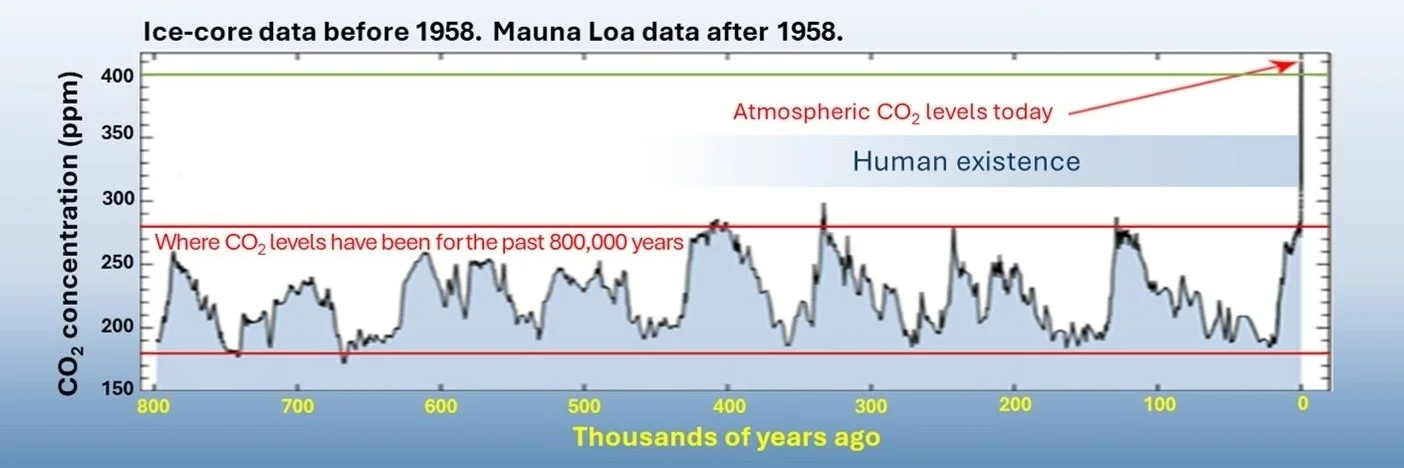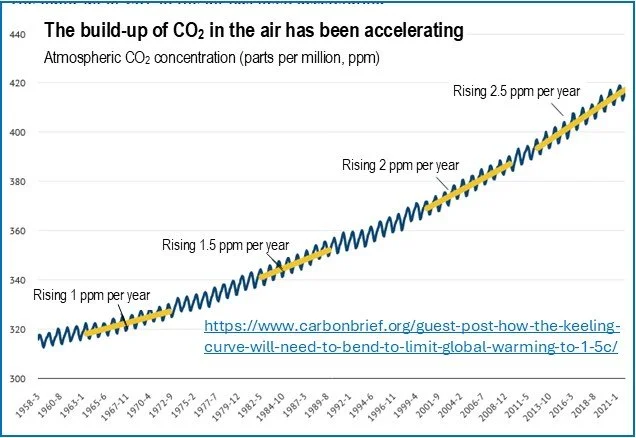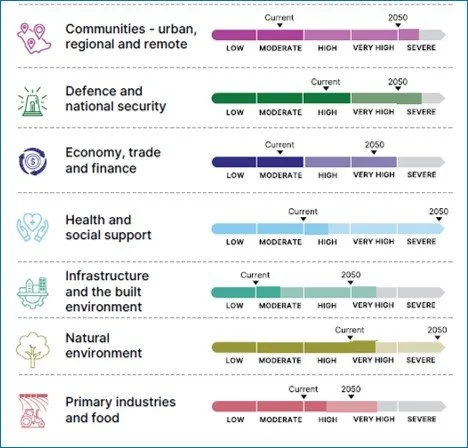The case for an Australian Pollution Price
This “Milankovich Cycles” chart is showing that for most of the past 800,000 years atmospheric CO2 concentrations varied between 180 ppm(ice-ages) and 280 ppm (warm inter-glacial periods)—for at least 400,000 years before the first evidence of human existence.
Earth should now be entering another cooling period but then . .
2. This happened …
Concentrations of CO2 are building up in the atmosphere because of human-caused emissions from fossil-fuel burning and deforestation. They are now at levels 50% higher than before the Industrial Revolution. Once in the atmosphere, CO2 can remain there for hundreds of years. The huge scale of global emissions means that it is being added to the atmosphere much more rapidly than natural processes can remove it. Global emissions have steadily increased over the past 60 years, which means that CO2 has been building up in the atmosphere at an accelerating rate.
This can be seen in the figure below, which shows the full record of the “Keeling Curve”. In the late 1960s, CO2 levels were rising at a rate of about 1 part per million (ppm) per year. By the early years of the 21st century, this rise had accelerated to 2ppm per year, and it accelerated further to nearly 2.5ppm annually in the last 10 years.
1. The way it was …
3. Consequences?
A government-ordered regional Climate Security Risk Assessment (CSRA), completed in 2022 by the Office of National Intelligence (ONI), remains classified. Briefed before the 2025 election, Senator David Pocock described it as ‘frankly terrifying’. (https://www.thesaturdaypaper.com.au/edition/2025/03/15)
Australia’s first domestic National Climate Risk Assessment (NCRA), released in September2025, was prepared without access to CSRA.
Managed by DCCEEW, NCRA was compiled by the Australian Climate Service, a collaboration of BOM, CSIRO, ABS, and Geoscience Australia.
The chart below summarizes the severity of climate risks identified in the NCRA.
4. Government response?
The government claims reductions of domestic (~1% of global) emissions as shown in Figure P1 below.
Meanwhile, rejecting any form of carbon pricing, it commits tens of billions of dollars in annual concessions for fossil fuel exports—that’s > 5% (and rising) of global emissions that also impact Australia.
However, Figure 4 above shows that the claimed emissions reductions are heavily influenced by LULUCF, the land use sector that delivers the ‘offsets’ for real emissions that have remained virtually unchanged since 2005.
Figures P1 and 4 were taken from DCCEEW’s March 2025 Quarterly Inventory of Australia’s Greenhouse Gas Emissions. https://www.dcceew.gov.au/climate-change/publications/national-greenhouse-gas-inventory-quarterly-update-march-2025
5. What’s needed?
Policies that price climate pollution and drivedown emissions fast:
Australian Pollution Price (APP)
A price on the greenhouse gas content of fossil fuels at source (mine, well or border) equivalent to the European Union’s ETS (currently ~AU$130/tonne).
Similar to Garnaut’s proposed Carbon Solutions Levy (CSL), APP is an advance payment for pollution wherever it may be emitted. It will incentivise fossil fuel producers to reduce their emissions rather than buy cheap, questionably valid offsets that should be used to remove atmospheric carbon rather than justify more emissions.
Australian Climate Dividend (ACD)
Revenue from APP distributed equally to all residents in monthly dividends is a politically attractive policy that will enable the community to absorb higher prices passed on by businesses, and to choose low carbon alternatives that will be relatively cheaper.
Australian Border Adjustment Mechanism (ABAM)
APP refunded for exports to, and applied at the border for, imports from countries without an equivalent pollution price.
Political Will
Since 2013 Australian governments have refused to consider any form of carbon pricing, fearing backlash from powerful corporations and electors. Real change will come when the government sees that policies like APP, ACD, and ABAM—along with other measures—can win elections, boost the economy, cut emissions, and help tackle the climate crisis.





